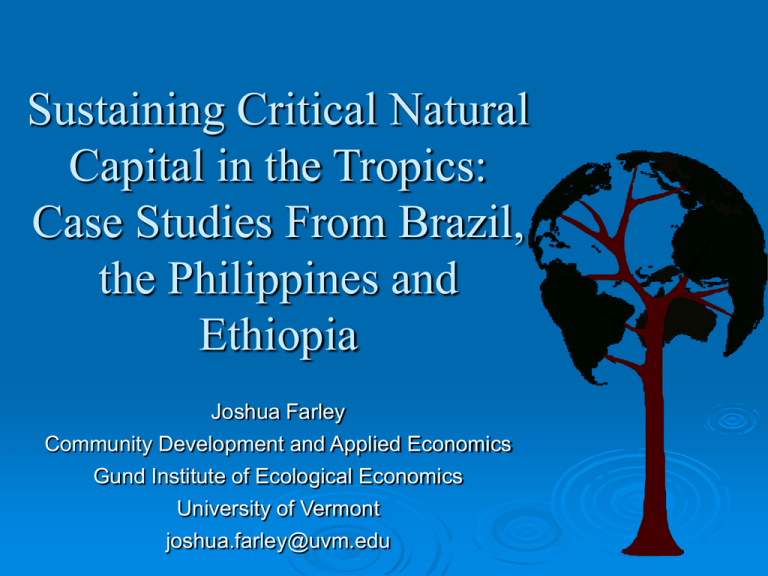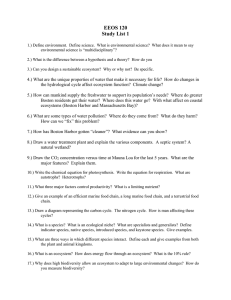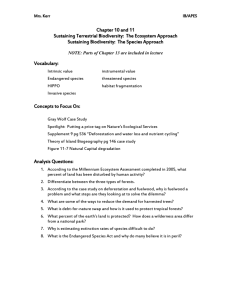Sustaining Critical Natural Capital in the Tropics: Case Studies From Brazil,
advertisement

Sustaining Critical Natural Capital in the Tropics: Case Studies From Brazil, the Philippines and Ethiopia Joshua Farley Community Development and Applied Economics Gund Institute of Ecological Economics University of Vermont joshua.farley@uvm.edu Outline of Presentation • Critical Natural Capital and its Economic Value • Case studies: – Brazil's Atlantic Forest – Palawan's mangrove ecosystems – Ethiopia's rift valley • Macro-allocation and the Tragedy of the Non-commons • Providing global public goods Critical Natural Capital • Components of natural capital that are essential to human survival and for which there are no adequate substitutes • Ecological thresholds • Ignorance and uncertainty • Cuts across source, service, sink and site – Function and location matter • Interdependent elements of complex system Characteristics of CNC • Uncertainty – E.g. passenger pigeons, sardines – Sample size of one • Thresholds – E.g. Amazon, passenger pigeons • Time lags – Cassowaries, passenger pigeons Valuing Natural Capital: The Problem of Sustainable Scale • Inelastic demand – Resources that are essential and have no substitutes, e.g. critical natural capital – Small changes in quantity lead to large changes in marginal value – E.g. California’s energy crisis, rising food prices value Marginal Marginal Value The Demand Curve for Natural Capital Critical: Perfectly inelastic demand Marginal valuation meaningless Important: inelastic Demand Marginal valuation inappropriate Valuable: elastic demand Marginal valuation may be acceptable Demand curve for natural capital Natural stocks NaturalCapital Capital Stocks Perverse Nature of Monetary Measurements value Marginal Marginal Value Critical: P2 Perfectly inelastic demand Important: inelastic demand Valuable: elastic demand Demand curve for natural capital P1 The loss of agriculture does matter even if it’s only 3% of GNP Q2 Q1 Natural Capital Stocks Natural Capital stocks Valuing Natural Capital: The Problem of Distribution • Most monetary valuation techniques based on estimating demand curve • Demand = preferences weighted by income • Allocation principle: one dollar, one vote • More desirable principle: one person, one vote Valuing Critical Natural Capital • Makes no sense to estimate demand curve for CNC • Relevant value is determined from supply curve—how much will it cost to restore CNC to sustainable level? Case Study 1: Brazil’s Atlantic Rainforest •Project: Reforestation as a Watershed Management Tool •Conceição de Macabu, Rio de Janeiro •Workshop/Field-course in partnership with Pró-Natura, local university, local government, local stakeholders Highest Biodiversity Terrestrial Ecosystem Known; 93% gone Rule of thumb from Island Biogeography: Loss of 90% of Ecosystem eventually leads to 50% loss of biodiversity Without immediate action to restore ecosystem, biodiversity may collapse; irreversible and catastrophic change •Forest Preserves water quality, quantity •Watershed supplies local community with water •Regulates water flow •protects against flooding and drought •Recent floods and droughts associated with deforestation •Protects against erosion •Regulates the microclimate (local, global) •Protects against disturbance, fire, etc. •Nutrient cycling •Many other services •May be flipping to fire prone ecosystem, threatening remaining forest •Nearing irreversible and catastrophic ecological threshold •Marginal value infinite, marginal analysis inappropriate. -Converted to pasture for $20/ha/yr. Why? -Tragedy of the non-commons: Private property rights lead to unsustainable, unjust and inefficient management Case study 2: Conversion of Mangrove Ecosystems to Shrimp Aquaculture The Tagabinet Community Problem Definition 1 World Bank identifies inadequate GNP in Philippines as problem Export based growth is solution Conversion of mangrove ecosystems to shrimp Aquaculture provides high short term profits Conversion of natural capital to financial capital The Result: Conversion of Mangrove Ecosystems to Shrimp Aquaculture Values of Natural Capital: Mangrove Ecosystems •Structure, raw materials •Building materials, charcoal, food •Function, services •Habitat, nursery for 80% of commercial seafood species •Storm, tsunami protection •Waste absorption •Climate stabilization Shrimp Aquaculture •High short term profits, heavily promoted by economists •Shrimp and fish for 3-5 years •Carnivorous, net reduction in food production •Less protein than intact ecosystem •Massive waste output •Irreversible(?) destruction of ecosystem Why Convert? •Shrimp: high profit, short lived •Intact mangroves produce more seafood than ponds •Benefits of conversion go to individual •Benefits of preservation go to local, regional, global community •Conversion only occurs with private ownership •Greedy self interest creates invisible foot •Tragedy of the non-commons The Result • Remaining mangroves likely to constitute critical natural capital Problem Definition 2 • How much mangrove ecosystem should be left intact to provide vital ecosystem services, how much should be converted to aquaculture? • Private property rights and markets systematically allocate mangroves towards aquaculture. • Mangrove restoration likely to be more economic than conversion. Analysis, synthesis and communication … … leads to action … and a more sustainable, just and efficient allocation of resources Case study 3: Green Awassa: Investing in Human and Natural Capital in Ethiopia Problem: Deforestation contributes to energy shortage, food shortage and water shortage. All are essential and non-substitutable Deforestation leads to loss of built capital as roads erode… No trees = no firewood (biomass = 95% of energy use) ….Burning dung in absence of firewood deprives crops of fertilizers Deforestation destabilizes hillsides …resulting in greater runoff, erosion and erosion gullies… …rising lake levels that encroach on farmland … less food production …and the threat of hunger • Riparian and gallery forests no longer filter water, reducing quality • Deforestation and soil compaction may cause flooding, drought • Forest loss may be affecting rainfall, reducing quantity Forest loss threatens biodiversity Conventional solution • More built capital – Direct foreign investment and democracy – DFI and instability • Increase food production with tractors and fertilizers – Fossil fuel prices rising – Constant repairs required – Foreign exchange required Alternative Solution • Invest in human capital– create and disseminate knowledge on – – – – Sustainable farming Efficient stoves Non-wood building materials Education on ecosystem services • Invest natural capital – Forest restoration to provide energy, food, water • Local resources, self sustaining Sustainable farming Alternative building materials Environmental education And Restoration of CNC The Economic Problem • Macro-allocation: How do we allocate finite ecosystem structure (forests) between: – Economic production (conversion, timber) – Production of life sustaining ecosystem goods and services • How should we distribute resources among individuals? – Who is entitled to ownership of ecosystem goods? – Is anyone entitled to ecosystem services? The “Tragedy of the Non-Commons” • Occurs when private ownership is ecologically unsustainable, socially unjust, and/or economically inefficient • Any privately owned resource that provides non-rival benefits The Global Problem • No global institutions that can mandate provision of globally critical ecosystem services • Poorest nations cannot afford to invest in maintaining natural capital • Poor nations require both incentives and resources to provide global ecosystem services The Solution • Nations rich in built/financial capital pay those rich in natural capital for its provision • Poor nations ‘export’ carbon sequestration, biodiversity conservation, etc. • Valuation of demand for CNC a waste of time. • We should value cost of restoring CNC, and generate the money • $.04/liter tax on gasoline in wealthy nations would generate 100x current expenditures on biodiversity conservation




